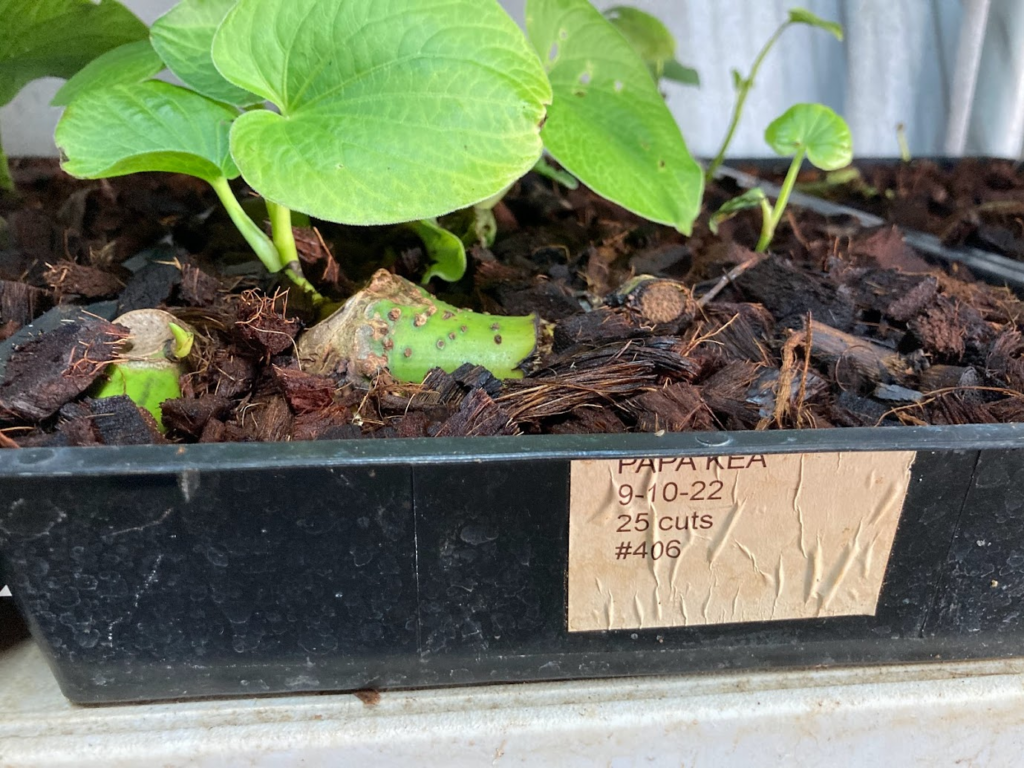
The term “cultivar” is derived from the combination of “cultivated” and “variety” and refers to a specific plant or group of plants that have been intentionally selected for their desirable traits and can be maintained through propagation [1]. Due to the fact that kava is incapable of generative propagation, which means it is unable to reproduce sexually and must be planted manually, each kava plant is essentially a genetic duplicate of the original. The creation of different kava cultivars is achieved through somatic mutations, which arise in non-sexual cells and can result in varying morphotypes, such as differences in internode height, length, and color, leaf size, and chemical composition [2]. These mutations have been carefully selected for their superior or inferior psychological effects and taste. Inferior plants have been discarded, while those with superior traits have been saved and propagated from cuttings [3]. These cuttings, which have been propagated for several generations, are now recognized as cultivars. This process continues to this day, with farmers occasionally identifying mutations within their crops [4].
Historically, as well as presently, it has been common practice for kava merchants to combine different cultivars when producing a product. This practice stems from the fact that multiple farms would typically sell their kava to a single processing facility [5], where the kava would then be combined during processing, resulting in the inability to distinguish individual cultivars. However, this practice was not necessarily detrimental, as some of the most highly sought-after kavas in the market are blends. Nevertheless, we are now observing a growing trend among exporters and merchants to market and sell single cultivar kavas.
This is overall a positive direction for the industry however some issues do remain.
Cleanliness – Maintaining cleanliness is a pressing concern for the entire kava industry. Kava has been found to naturally harbor a substantial quantity of bacteria and fungi (especially in the peelings) [6], making it imperative to observe appropriate handling procedures and cleanliness measures to produce superior quality products with minimal bacterial and fungal contamination.
Proper Identification – Presently, identification of cultivars within the kava industry is entirely dependent on the ability of farmers, intermediaries, or processing facilities to accurately distinguish specific cultivars. This involves either visually examining the entire plant or receiving at least one complete stem with attached leaves to make an accurate identification. Although larger processing facilities are currently exploring the implementation of DNA marking for cultivar identification, the majority, if not all, still rely on the knowledge of individuals to differentiate cultivar types.
Identification can be problematic, as numerous cultivars may have comparable visual characteristics, and without sufficient training, incorrectly labeled cultivars may be sold. Once the kava is processed into powder and packaged, the accuracy of cultivar identification can only be confirmed through analysis of the average chemotypes. A single cultivar kava should demonstrate consistent chemotypes, even if cultivated in diverse regions [7]. For instance, if a particular kava has an acknowledged chemotype of 421365, the chemotype should remain in proximity to this, with only the final few digits varying, such as 421356 or 423156. However, if the initial three digits begin to differ, the authenticity of the claimed cultivar should be questioned. It is particularly crucial to monitor DHM, or the kavalactone represented by the number 5, in this context. If the accepted chemotype has the #5 located far to the right, but the tested chemotype has the #5 situated towards the left, it’s possible that a different kava has been utilized.
Given the rising demand for single cultivar kavas, it is of utmost importance for all stakeholders within the industry to handle and identify the various cultivars with great care and accuracy. If they don’t, this exciting new trend could fizzle out before it even gets started.
[1] Cultivar. Academic Dictionaries and Encyclopedias. (n.d.). Retrieved December 6, 2021, from https://en-academic.com/dic.nsf/enwiki/113677.
[2] Lebot, V., and J. Lèvesque. 1989. “THE ORIGIN AND DISTRIBUTION OF KAVA (PIPER METHYSTICUM FORST. F., PIPERACEAE): A PHYTOCHEMICAL APPROACH.” Allertonia 5 (2): 223–81. http://www.jstor.org/stable/23187398.
[3] Lebot Vincent, Cabalion Pierre. 1988. KAVAS OF VANUATU Cultivars of Piper Methysticum Forst. South Pacific Commission Technical Paper. https://horizon.documentation.ird.fr/exl-doc/pleins_textes/divers14-07/26842.pdf.
[4] I found a kava mutation. Kava Forums. (June 27, 2021). Retrieved December 7, 2021, from https://kavaforums.com/forum/threads/i-found-a-kava-mutation.18741/.
[5] PHAMA. 2018. FIJI KAVA VALUE CHAIN ANALYSIS. Australian Government and New Zealand Government. https://phamaplus.com.au/wp-content/uploads/2018/06/Fiji-Kava-Value-Chain-Analysis-Report-FINAL.pdf.
[6] Singh, Yadhu N. 2004. Kava: From Ethnology to Pharmacology (Medicinal and Aromatic Plants – Industrial Profiles). CRC Press.
[7] Siméoni, Patricia, and Vincent Lebot. 2002. “Identification of Factors Determining Kavalactone Content and Chemotype in Kava (Piper Methysticum Forst. F.).” Biochemical Systematics and Ecology 30 (5): 413–24. https://doi.org/10.1016/S0305-1978(01)00093-X.


